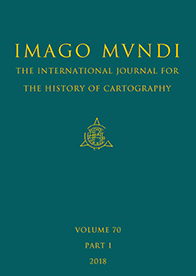Squaring the circle: how Mercator constructed his projection in 1569
- Author(s)
- Year
- 2014
- Journal
Imago Mundi, 66.1
- Nr. of Pages
- 1-24

In this study we assess the accuracy of the cartographic projection introduced by Mercator in his world map of 1569 aiming to identify its construction method. An error distribution of the latitude scale in the Organum directorium abacus was first determined in such a way as to be independent of the physical distortions that affected the sheets after printing. This distribution, which we have called the ‘error signature’ of the map, was then compared with the errors associated with various methods that Mercator might have used to calculate the projection. A new construction method not hitherto considered in the literature, based on the use of a table of rhumbs, is proposed and tested. The method is intuitive, simple to apply and historically plausible, given the fact that tables of rhumbs were already known in Europe at the time Mercator was engraving his world map. A particular type of table, based on the iterative resolution of a set of right-angle triangles placed along a rhumb line on the sphere, at regular longitude intervals, was found to reproduce the error signature of the map better than any other method.